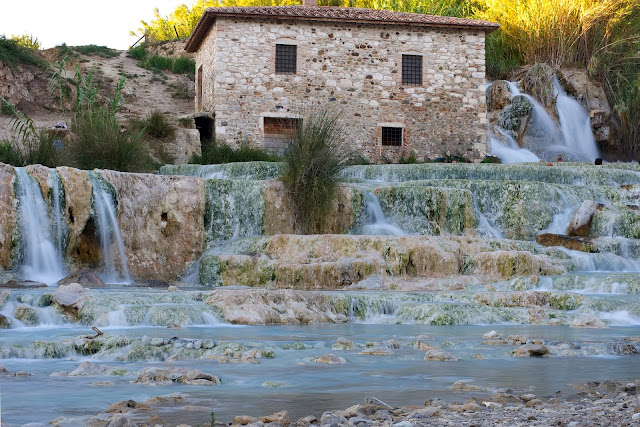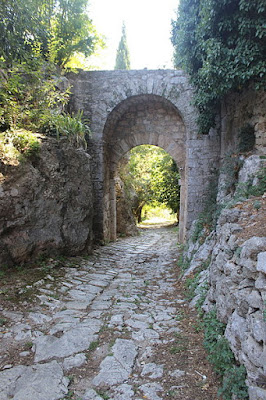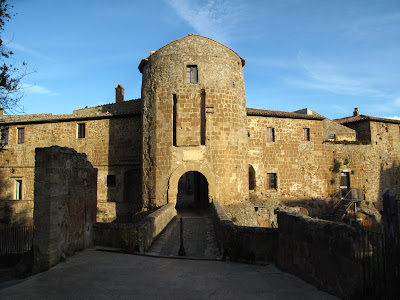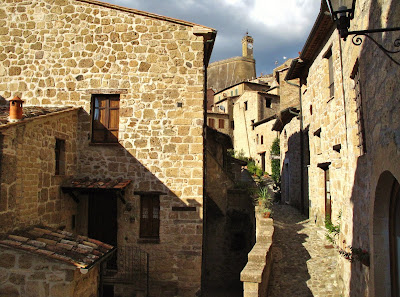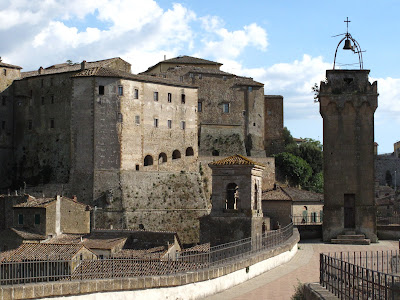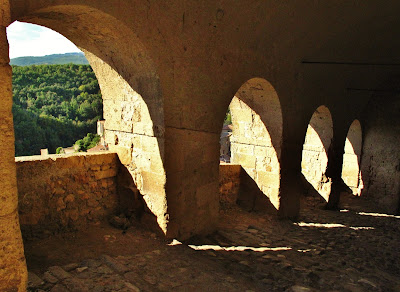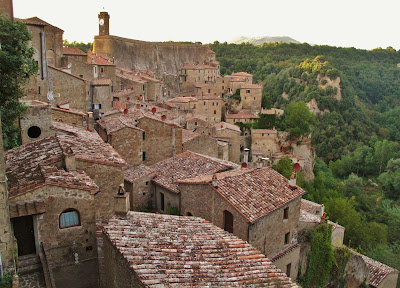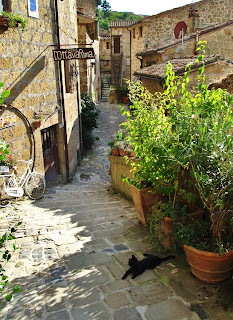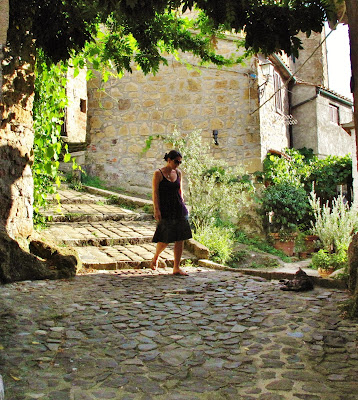Tuscany is blessed with numerous thermal baths, known as "terme" in Italian. Hot water springs from deep within the Earth, holding healing properties that make this area of Italy a paradise for spa lovers.

The Maremma region in Southern Tuscany is dotted with delightful thermal waters, resulting in both natural outdoor pools and spa resorts. Southern Tuscany's sulfuric Terme waters also boast some of the most healing properties in all of Italy. One of the best places to experience Terme in Tuscany is the quiet village of Saturnia, located in the deep south of Grosseto Province, near the border with Lazio.
The settlement at Saturnia was called Aurinia by the Etruscans. A settlement has existed here since pre-Etruscan times and is thought to be one of the oldest cities in Italy, most likely due to the abundance of thermal springs. There are Pre-Etruscan tombs in the area, like the Necropoli del Puntone (1 KM North of Saturnia on the road to Poggio Murello) that establish Saturnia as a Pelasgi settlement which was the region's indigenous people.
Etruscan and Roman structures around the village of Saturnia include the Etruscan walls, dating back to the 3rd and 4th centuries BCE, which incorporate the "Porta Romana," a Roman-era city gate. The Via Clodia, a Roman road that leads to the Porta Romana, was built on an existing Etruscan Route linking Pitigliano, Sovana and Sorano, incorporating some of the mysterious Via Cave. Check out my blog posts on these nearby attractions. There are also remains of the ancient Roman baths at the far end of town on Via Italia. There is also a picturesque castle in Saturnia called the Rocca di Saturna or Castello Ciacci by locals. This was an Aldobrandesca Fortress built in the 1100s along the fortifying city walls by the original rulers, the famous Aldobrandeschi family of Sovana. While in Saturnia, be sure to visit the small but interesting archaeological museum.
The name Saturnia came from the Romans, who settled this area in 183 BCE. Legend has it that the Roman God Saturnus (Saturn) was tired of the constant warring among humans in the area. In a rage, Saturnus threw a thunderbolt from the heavens down to Earth, and where the thunderbolt stuck, a magical spring of warm water was created to pacify humankind. This is the main attraction of Saturnia today.
 There are two terme areas in Saturnia, a posh hotel spa and a natural thermal waterfall; both of these originate from the same source. The Terme di Saturnia Natural Spa and Golf Resort is a 124-room Five-Star hotel resort for those who want to pamper themselves. You can book a full-day (€29) or half-day package (€25) at the resort without having to stay overnight in the hotel, which is an excellent alternative to the busy free hot springs. Check out the resort website at termedisaturnia.it and navigate to the "Reservations & Gift Vouchers" section at the top right of the homepage to book a day package.
There are two terme areas in Saturnia, a posh hotel spa and a natural thermal waterfall; both of these originate from the same source. The Terme di Saturnia Natural Spa and Golf Resort is a 124-room Five-Star hotel resort for those who want to pamper themselves. You can book a full-day (€29) or half-day package (€25) at the resort without having to stay overnight in the hotel, which is an excellent alternative to the busy free hot springs. Check out the resort website at termedisaturnia.it and navigate to the "Reservations & Gift Vouchers" section at the top right of the homepage to book a day package.The more popular destination attracting locals and tourists alike is Gorello Falls. An ancient stone mill sits atop Gorello Falls, also known as "Cascatelle del Mulino," or Miller's Falls, to the locals. This is where one can sit outside in a cascade of warm water... FOR FREE!!!

Gorello Falls can be a hectic place, even in the offseason. Follow the Strada Provinciale SP10 south from Saturnia towards Montemerano for about 2km, and you will see signs for the falls. There are two parking lots for the springs, both are free. The first and closest option is a large dirt parking lot at the end of Via della Follonata, which can be quite rough in spots where there have been seasonal washouts. The overflow parking lot is also located on the SP10, just past the falls, and is a slightly farther walk to the springs.
I visited Gorello Falls on a Sunday afternoon in late September, and the place was absolutely packed! Robust Russians were padding around in bathrobes, sexy Italian couples on their Vespas, German families camping out in Westfalias, and even locals with horses tied up in the shade of the treed parking lots! It was a smorgasbord of people watching, and everyone was having a wonderful time.
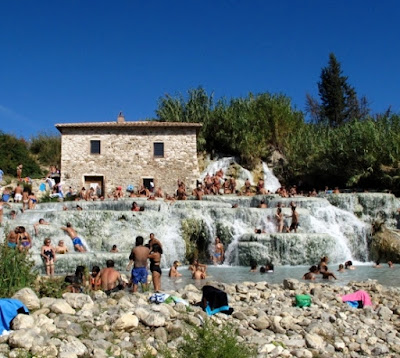
You can smell the water before you see it; the slightly sulfuric scent emanates from the healing waters, which are at a perfect temperature of between 37 °C and 38 °C. Cobalt blue calcium-rich water cascades down layered basins of smooth, white limestone at a rate of 800 litres per second. Each of the little pools can hold about 3-5 adults quite comfortably. Sitting in one of these stacked pools gives you the feeling that you are a giant pigeon in a warm Italian fountain! The healing properties of the water are said to help cure vascular diseases and ease muscle tension and pain. The mineral-rich black mud found at the bottom of the falls is known to alleviate skin disorders such as eczema and psoriasis, so it's common to see people smearing the dark clay all over their faces and bodies. Remember, there are no storage facilities available at Gorello Falls, so please lock all your valuables in the trunk of your car and bring only your towel to the falls.
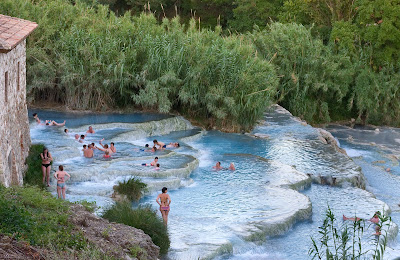 |
| Gorello Falls In The Evening |
The best times to visit Cascate del Mulino during the busy tourist season, from April to October, are early in the morning, before 10:00 a.m., or in the evening, after 5:00 p.m. There is a cafe/bar located near the falls that serves hot and cold snacks, sandwiches, gelato, and desserts, as well as beer and cold beverages. The cafe also provides shower and washroom facilities. The Bar Cascate di Saturnia opens daily at 8 am and closes late.
UPDATE: MARCH 2025- The restaurant Bar Cascate di Saturnia was closed for renovations, but the toilets/changerooms attached to the bar remained open. You can access these from outside the bar.
Saturnia's hot springs have something for everyone, from elegant spas to free family fun, to romantic midnight dips under the moon and a blanket of stars❣
Have you visited Saturnia, Tuscany? Which Terme did you prefer: the Spa or the free natural springs? Let me know in the comments below.
Follow me on FACEBOOK, INSTAGRAM and BLOGLOVIN' for daily photos and updates! #slowtravel🐌
This post first appeared in September 2013 as Saturnia Tuscany; Saturn's Bathtub
